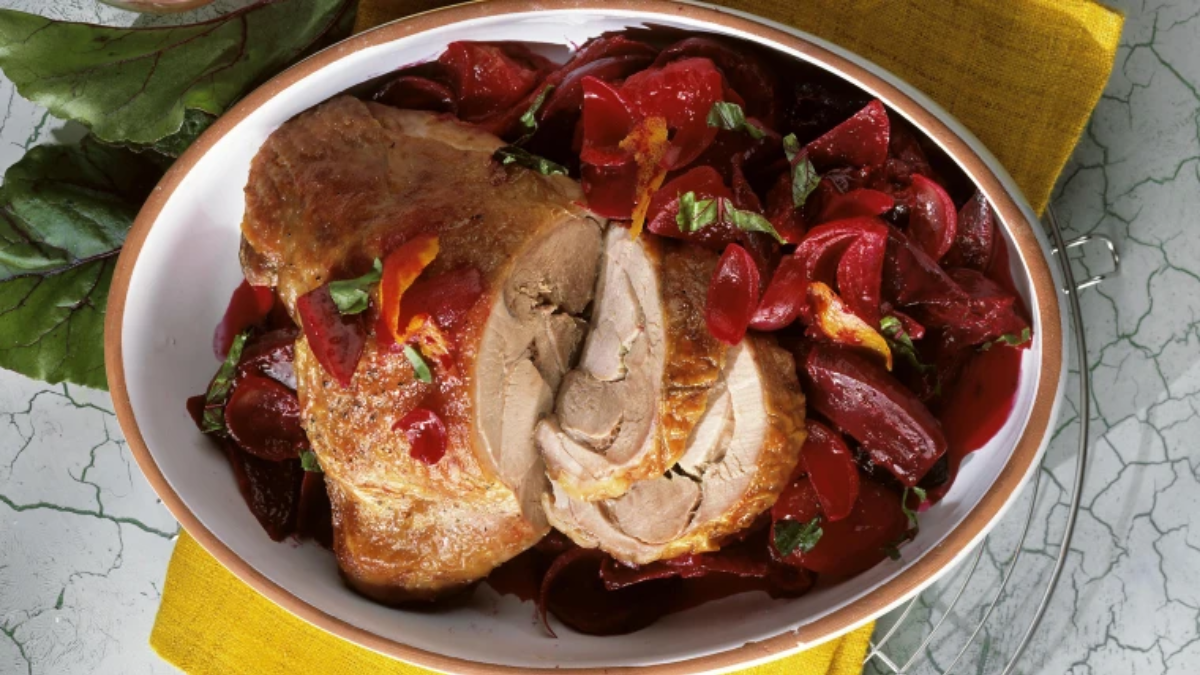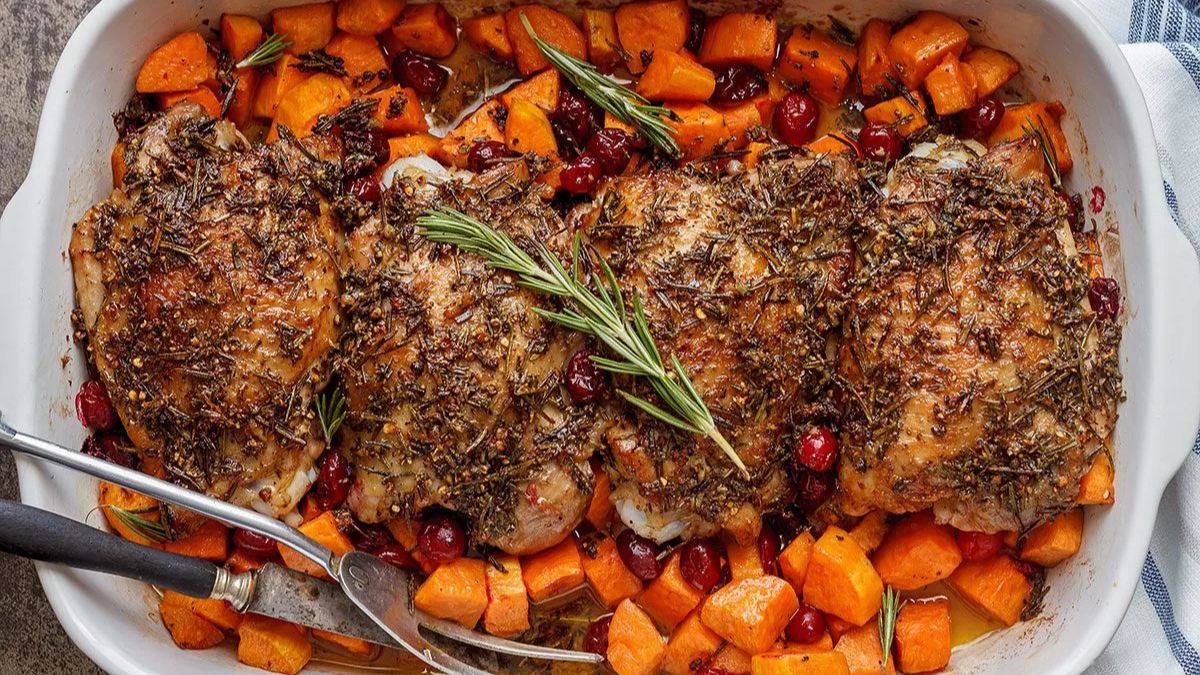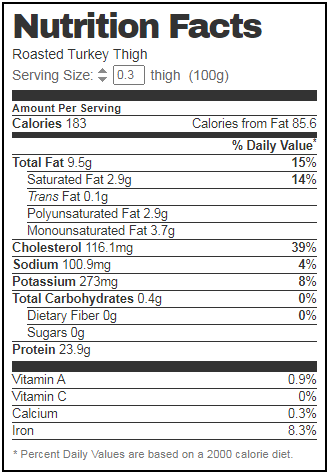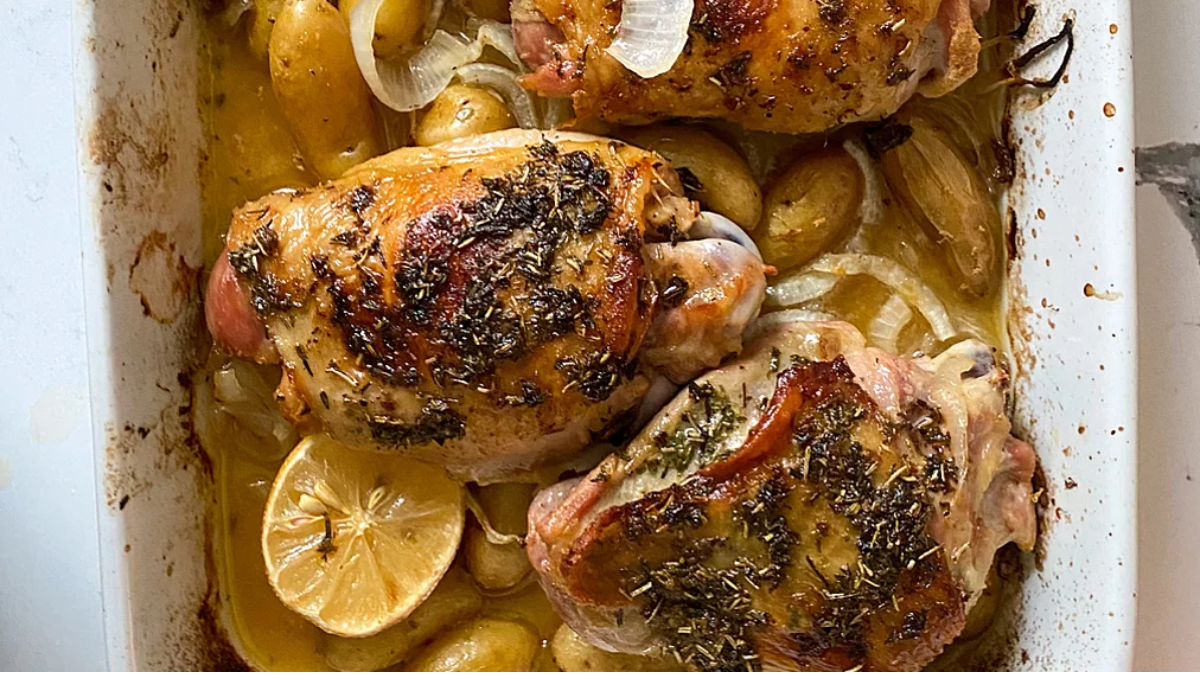Those who enjoy dark meat will love this delicious and simple dish for turkey thighs. A full turkey may be too much for a little Christmas dinner, but the meaty thighs from the bird’s legs are perfect. Another excellent substitute for chicken thighs is bone-in turkey thighs. The great technique to prepare this dark meat for dishes like salads and casseroles is to roast turkey thighs. The flesh is tasty, soft, and juicy; it doesn’t dry out as quickly as white meat.
Because the meat dries out far less quickly than turkey breasts, roasting turkey thighs is a terrific alternative to cooking a complete bird. They are ideal for Thanksgiving dinner for two or even a small gathering.
Some people might prefer to cook individual turkey thighs rather than a whole turkey because some turkey sections take longer to cook than others, making it difficult to avoid overcooking some portions before other parts are done. Many techniques frequently work because turkey thighs are dark meat, which keeps its moisture better and is less likely to dry out than white flesh.
Turkey Thighs Nutrition Facts
What is Exactly Turkey Thigh?
One popular form of packaged turkey portion is the thighs, which come either bone-in or boneless. Some people might prefer to cook individual turkey thighs rather than a whole turkey because some turkey sections take longer to cook than others, making it difficult to avoid overcooking some portions before other parts are done. Many techniques frequently work because turkey thighs are dark meat, which keeps its moisture better and is less likely to dry out than white flesh.
One of the most popular preparation methods is roasting a turkey thigh in the oven. To make the skin crispier when roasting turkey thighs, the pieces are frequently first seasoned and then covered in oil or melted butter.
How to Roast Turkey Thighs?
A meat thermometer is a useful tool to have on hand to ensure that the meat is thoroughly and safely cooked for this meal. The meat is fully done when the thickest section of the thigh meat reaches 165 F. If you wish to freeze leftovers or serve more people, you may easily double this recipe.
Ingredients
- 3 (1-pound) bone-in skin-on turkey thighs
- 1/4 cup (4 tablespoons) unsalted butter, softened
- One teaspoon salt
- 1/4 teaspoon pepper
- Two cloves of garlic, minced
- One teaspoon of dried thyme leaves
- One teaspoon of dried sage leaves
- 1/2 cup turkey broth or chicken broth
Steps to Make
- Gather the ingredients and heat the oven to 350 F.
- Utilize paper towels to pat the turkey dry. Never rinse a turkey before cooking it since doing so will cause the bacteria on the surface of the meat to aerosolize and spread around your kitchen. A thorough pat-dry is a dependable technique that is sufficient to allow the seasonings to stick to the skin.
- The softened butter, salt, pepper, garlic, thyme, and sage should be combined well in a small bowl.
- Remove the meat’s skin and rub part of the butter mixture into it. Reapply the butter mixture to the skin and smooth the surface again.
- Put the turkey in a roasting pan with the thighs on top, then cover with the broth.
- The turkey thighs should be roasted for 60 to 70 minutes, or until a meat thermometer inserted into the meat away from the bone reads 165 F.
- Before serving, let the pan rest for ten minutes after removing it from the oven and covering it tightly with foil or the pan lid. Enjoy.
Which Variations can you Use for Tukey Thigh?
Cook the thighs according to these instructions, but have fun creating your seasoning concoction. Here are some suggestions:
- Citrus: Place the thighs in a zip-close bag, and add the juice and zest of two lemons and two tablespoons of maple syrup or honey. Marinate for 30 minutes before using the herb butter. Add lemon slices to the bottom of the roasting pan plus the marinade juices, and place the thighs on top before roasting.
- Herb: Use a small handful of finely chopped cilantro, Italian parsley, and basil instead of thyme and sage. Mix with the butter, rub on the thighs, and roast.
- Mustard: Mix 1/4 cup Dijon mustard with two tablespoons of honey, butter, and other ingredients, except the thyme and sage. Cover the thighs with the mixture and roast.
- Bacon: Follow the recipe as is but wrap each thigh in two to three bacon strips. Cook until the meat has reached a safe temperature and the bacon has crisped.
- Swap out the dried herbs with fresh herbs, about one tablespoon of fresh thyme leaves and one tablespoon of minced fresh sage.
- Instead of sage and thyme, use 1 1/2 teaspoons of poultry seasoning.
What are the Health Benefits of Turkey Thigh?
Here are the health benefits of turkey thigh:
Rich in Protein
Turkey is a slice of lean meat that is a fantastic option for anyone trying to cut back on their fat intake because it is lower in fat and higher in protein than chicken. However, because it has a lot of protein and little fat, the meat might cook quickly and end up being dry.
Good Source of B vitamins
Turkey meat is a good B vitamin family source, including vitamins B3, B6, and B12. These vitamins are essential for creating red blood cells, brain health, and energy production.
Good Source of Minerals
Turkey meat is a valuable addition since it is high in selenium, zinc, phosphorus, and iron, which help thyroid function, immunity, bone health, and energy production. The darker meat pieces, such as the leg and thigh, are higher in iron-rich elements.
May Support Heart Health
The low fat, high protein, and wide range of micronutrient contributions of turkey all contribute to its potential heart-health benefits. Higher diets of poultry and fish were linked to a lower risk of coronary artery disease, according to extensive observational research on females. Additionally, it appears that switching from red meat to poultry decreased the cardiovascular risk by 19%.
Turkey vs. Chicken: Which is Healthier?
Are you unsure about your position on the chicken vs. turkey controversy? Continue reading if so. You can choose which type of lean meat to eat by looking at the information provided below:
Facts on Chicken
Chicken has become a mainstay in most people’s diets who start eating cleanly to lose weight. But how nutritious is chicken?
The White Meat
White flesh and dark meat are both present in chicken and turkey. White meat is lighter because it contains less myoglobin, a protein essential for carrying and storing oxygen in the muscles. Dark meat has a reddish-brown color because it includes larger levels of myoglobin.
The breasts and wings are the primary locations of the white meat in chicken and turkey. Chicken breasts are low in fat and calories and high in protein. About nine grams of protein and one gram of fat are found in an ounce of chicken breast meat. Additionally, it has about 46 calories.
Regarding protein content, chicken wing meat is comparable to breast meat with about nine grams per ounce. About two grams of extra fat per ounce can be found in chicken wing meat. To most people, though, this distinction is insignificant. The calorie content of one ounce of chicken wing meat is roughly 56.
The Dark Meat
The dark meat, what about it? Legs (also known as drumsticks) and thighs are where much of the black meat in chicken can be found.
Like chicken breasts and wings, chicken legs have a high protein content of about eight grams per ounce. With the skin still on, one chicken leg has 97 calories and 12 grams of protein. Additionally, it has five grams of fat.
A skinless leg contains 66 calories and 11 grams of protein so you can cut a few calories. Additionally, it just has two grams of fat. Like chicken legs, chicken thighs are heavier in fat and protein than chicken breasts or chicken wings.
A chicken thigh with the skin on has about 64 calories, 6.5 grams of protein, and 4 grams of fat per ounce. A chicken thigh has just 55 calories, seven grams of protein, and 2.7 grams of fat per ounce without the skin.
More Facts on Tukey
So chicken is quite nutritious. Turkey, what about it?
The White Meat
The breast of the turkey is where you’ll mostly find the white meat. The calories, fat, and protein content of chicken breast and turkey breast are comparable. Per ounce, turkey breast has 44 calories, 6 grams of protein, and 2 grams of fat.
The protein content and fat content of chicken breast are slightly different. But these distinctions are usually insignificant to people.
The Dark Meat
Wings from a turkey, as opposed to chicken, are considered dark flesh. One roasted turkey wing’s energy and fat contents are about 220 calories and 11 grams, which undoubtedly contains more calories and fat than a chicken wing. They do, however, also include crucial micronutrients like the mineral selenium. Dark flesh also includes the legs and thighs of turkeys.
A turkey leg has about 47 calories, 1.5 grams of fat, and 8 grams of protein per ounce. Turkey thighs have comparable amounts of calories, protein, and fat to chicken thighs. Turkey thighs have a calorie count of 45, 5.5 grams of protein, and 2.6 grams of fat per ounce.
Which you should Choose?
What position do you take on the turkey vs. chicken argument now that you know better about both protein sources?
Both chicken and turkey are lean, healthful foods that can support your weight loss efforts in the end. Do you need additional assistance in losing weight? Would you be interested in participating in a program that eliminates all nutritional uncertainty? The ChiroThin program may be ideal for you if this is the case.
Conclusion
When you only need to feed a small family for Thanksgiving dinner, roasted turkey thighs are the ideal option. They’re juicy, tasty, and simple to make! A deliciously juicy, flawlessly cooked turkey is one of the few holiday dinner ingredients that truly screams the season. This typically refers to a large bird that weighs ten or even 20 pounds. For some, however, who are hosting a modest party.
When properly wrapped and covered, turkey thigh flesh can be stored in the refrigerator for three to four days.
Wrap it tightly in foil or plastic wrap for extended storage, then place it in an airtight container or zip-top freezer bag for up to three months. This method is particularly effective if you intend to use the entire turkey—bones and all—for stock, soups, or other recipes.



